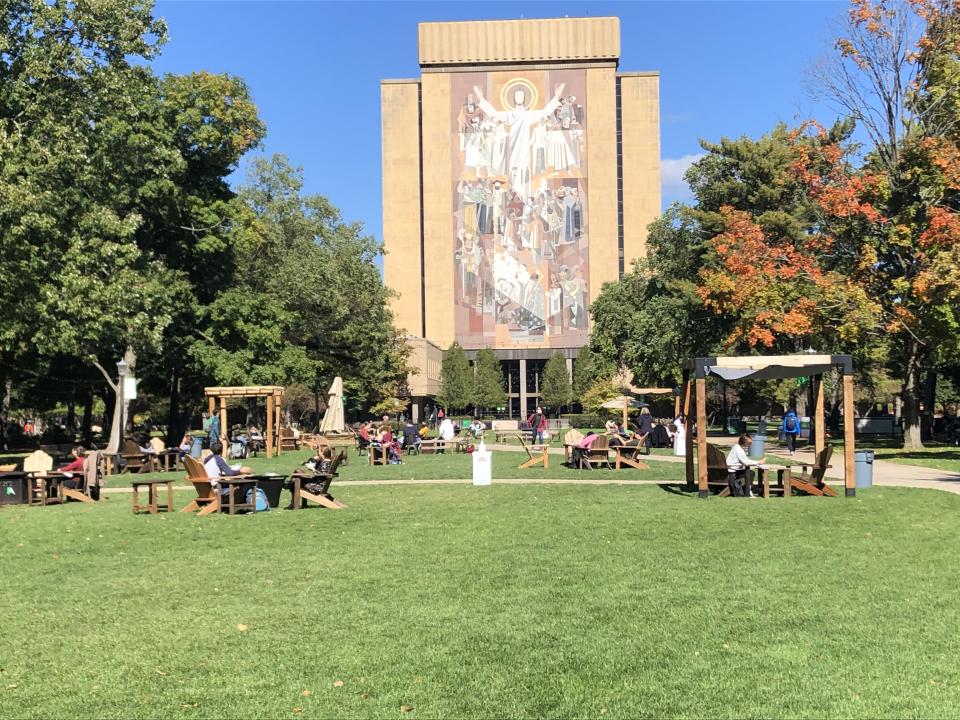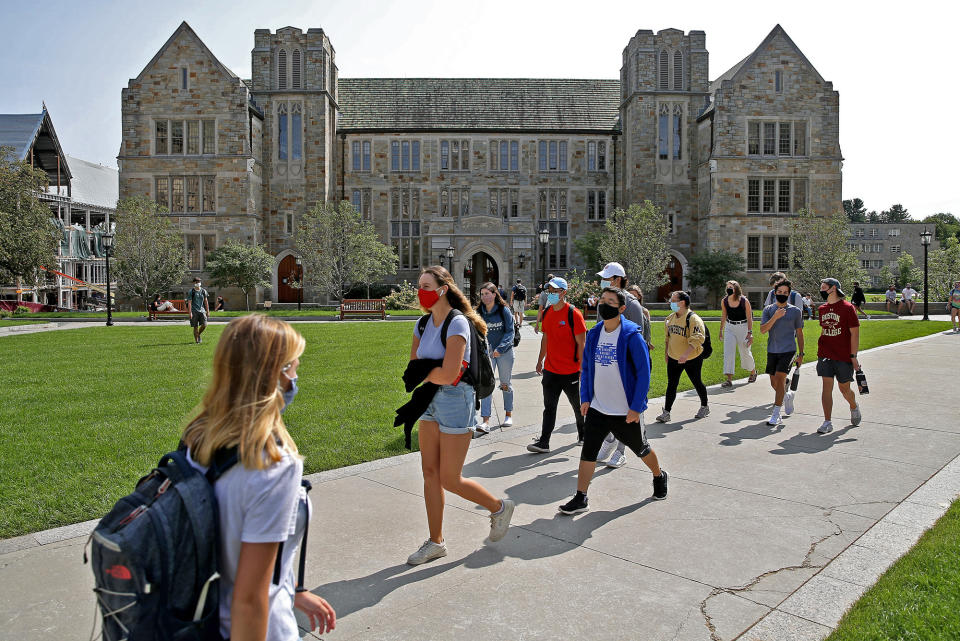College students preparing for Thanksgiving navigate complex rules and high risks
BOSTON — As Thanksgiving approaches, Duncan Donahue, a junior at Notre Dame University in South Bend, Ind., would normally go home for a quick break and then return to campus to finish out the semester.
But this year, amid a pandemic that has hit his university particularly hard, the school is ending the semester at Thanksgiving, and he and other students will return home for an extended winter break.
The university has suffered at least two public black eyes for its failure to control the pandemic on campus. Most notably, the university president, the Rev. John Jenkins, contracted the virus after appearing unmasked at a White House event in October. And earlier this month, a crowd of students and fans rushed the field after their football team defeated rival Clemson, creating a cringeworthy image.

“Notre Dame’s handling of the pandemic this semester has been an abject failure,” Donahue said, pointing to Jenkins’s unmasked appearance at the White House. It set a bad example for the community, and “students have stopped caring at all whether they catch COVID.”
According to the university’s COVID-19 Dashboard, there have been 1,741 reported cases, and most of those — 1,424 — have been among undergraduate students.
When many universities decided to allow students to return to campus during the pandemic and provide in-person classes in the fall semester, students and faculty raised questions about how safe campuses would be. Now, months down the line, as many college students prepare for Thanksgiving, they’re often being forced to make what could be for them and their families life-or-death decisions.
Across the country, universities are approaching the upcoming break according to their own sets of rules. Some, in an attempt to approximate as much of a normal experience as they can, are allowing students to return home to see their families, with the option to return to campus to finish the semester or remain home. And some are telling students that if they return home for the break, they should finish the semester from there.
Others, like Notre Dame, are simply ending the semester at the break, sending students home in an attempt to avoid the worst of the coronavirus spike that was predicted to strike once the colder weather and flu season hit.
A number of universities learned early on from mistakes in dealing with the virus. In September, at Boston College, after a spike in cases that stemmed from its swimming and diving teams, the state announced that it would “take the lead in contact tracing,” fearing that the institution was ill equipped to handle the virus.

Since then, the college has ramped up its testing. It has administered a total of 108,990 tests over the course of the semester, with just 350 total positive cases as of Nov. 21, including 67 undergraduates currently in isolation, according to the school’s website.
Brandon Kewalramani, a senior at Boston College, told Yahoo News he believes that the institution has done a good job of keeping students safe, but that some of the restrictions it put in place “do not make a whole lot of sense” and have affected morale, particularly for first- and second-year students who are struggling to find safe ways to socialize. One of the inconsistencies Kewalramani sees is in the dorm policy, which permits only two guests, while the college allows “up to six people to sit together inside of the cafeteria.”
“It is difficult to keep so many college students safe considering how social college students are,” he said, “but I think the rules put into place are good at trying to limit the pandemic on the community.”
Boston College is giving students the option to return home and finish the semester remotely, or remain on campus and finish the semester in person, and asked students to alert the school of their decision before the break. When asked if he believes there is a chance that students may violate the rules by going home and returning to campus without notifying the university, Kewalramani insisted that the “punishments for those who break the rules,” like the forfeiture of campus housing, and even suspension, “will do a good job preventing” that.
Not too far from Boston College, Boston University has managed to keep the virus at bay, reporting only 402 positive tests since July 27, with more than 400,000 administered. Gavin Benke, a senior lecturer at the university who expressed his concern to Yahoo News in August over the university’s plan, recently gave credit to the institution for its “aggressive testing.”
As a faculty member teaching in person for part of the week, he gets tested weekly, while students are tested more frequently. “I think that level of testing is the primary reason that BU hasn’t had a big outbreak,” he told Yahoo News.

Boston University is offering a similar plan to Boston College, but instead of requiring students who return home to remain there, it recommends that students who leave either remain at home or isolate on campus for a week upon return. Benke believes the message is a “welcome one,” as “having a lot of returning students would be problematic.”
While he is “generally worried” about Thanksgiving travel, Benke believes that most students who plan on going home would not return to campus until the spring semester.
While the two Boston schools have managed to keep the virus under control, other universities have had a harder time dealing with the continued spike in cases. The University of Wisconsin-Madison, for example, has had 4,854 positive cases since testing began on Aug. 6. The Midwestern university is offering students the option to leave the state for break and return, even though all classes will be remote after Thanksgiving. Students who decide to leave and return are being asked to self-isolate, monitor for symptoms and schedule a test if any symptoms do appear.
When asked about this plan, university student Annika Kersten Wellman deemed it “appropriate” but almost impossible to enforce. “No one knows who all is going home, where home is or what students will do at home,” she said. “That is what concerns me.”
“The recent spike in cases is concerning, and I know that local hospitals are suffering because of this,” Wellman said, adding that more needs to be done, “as far as consequences go” for violating gathering and distancing restrictions, to achieve any substantial improvement.
Wellman believes that the university’s testing of students pre-departure is “a good practice,” but insists that “keeping our circle small is one of the most important things right now.”
With cases rising recently, the university has asked traveling students to strongly consider whether they need to be on campus after break, and said that those who need to use university facilities after break refrain from leaving.

Wellman told Yahoo News that the university now has good access to testing, but she believes that access to mental health support is lacking. “People are scared, anxious, lonely and sad,” she said. “I think that access to mental health should be a priority for this university.”
Donahue, the Notre Dame student, has similar concerns. The effect of both COVID-induced stress and the university’s restrictions, he said, has led to “an extremely toxic environment.”
The university provost recently emailed professors informing them that a campus survey found that “50% of students qualified as having severe mental illness.”
In the meantime, like many other students, Donahue is ready to go home for the semester, but is worried about the safety of students’ friends and families. He said exit testing, which became available on Nov. 12, “should’ve only been available much closer to when students would actually exit,” instead of so far in advance.
There’s a chance, said Donahue, that sending students home on Thanksgiving without proper precautions could end up putting their family members’ lives at risk, even leading to deaths. “The thought that the conditions on campus could contribute to that reality for some families is absolutely horrifying,” he said.
_____
Read more from Yahoo News:



